The following is a transcript of the presentation video, edited for clarity.
CREd Library Note: This presentation is an update to the Biosketch section of the 2014 presentation Grantsmanship: Mechanics of Grant Writing.
Biosketch
This talk is about grantsmanship mechanics. It’s intended as an overview of what NIH grants consist of and the kinds of things you want to keep in mind as you’re going through the grant process.
 The biosketch. Your purpose for your biosketch, and for everybody else’s biosketch on your grant is to convince the reviewers that the key personnel needed to do the work are on the grant, and they have a track record of publishing in the area, and that they are important to the work being proposed. That’s what it’s supposed to accomplish.
The biosketch. Your purpose for your biosketch, and for everybody else’s biosketch on your grant is to convince the reviewers that the key personnel needed to do the work are on the grant, and they have a track record of publishing in the area, and that they are important to the work being proposed. That’s what it’s supposed to accomplish.
They just changed the format. The new format will be required in the next round of reviews that are coming up in June. And as a heads up, if you’re writing an F grant, the requirements are somewhat different for an F grant, so again check the instructions.
Personal Statement
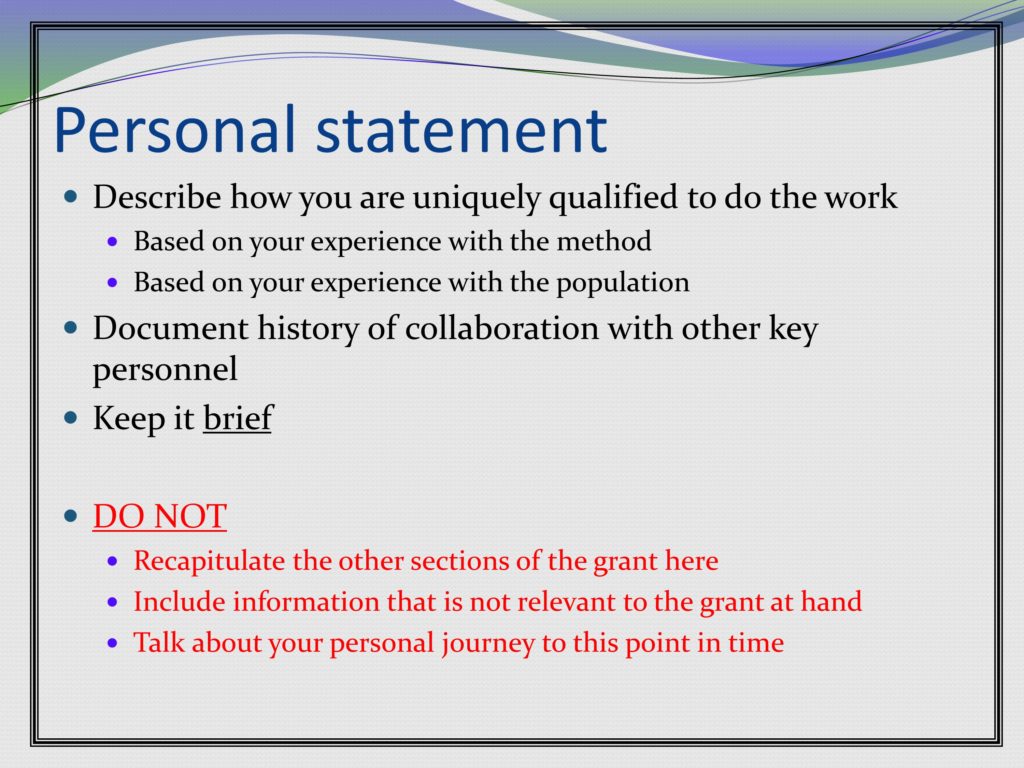 This is relatively new to a biosketch. This changed in 2010, so you might see some examples floating around in your department that are older than that, that don’t have it.
This is relatively new to a biosketch. This changed in 2010, so you might see some examples floating around in your department that are older than that, that don’t have it.
The purpose of this is to establish why you are qualified to do the work you are proposing. That’s what it’s supposed to do.
You can also use it to document that you’ve been collaborating with other people who are listed on your grant, that this is not your first rodeo, and that you can get along and work together.
Keep it brief. Do not, do not, do not recapitulate other components of the grant here. I’ve read the abstract, I’ve read the aims. I actually read the biosketch after I read the grant, so I know whether or not these people are a good fit for it. I’ve read the rest of the grant.
When I see the first page of a biosketch which is a full page of text, starting with how they discovered their interest in the field and wandering up to the present date. Or, if the first two paragraphs recapitulate the goals and approach of the grant, and then finally tucked in there is why they’re well-suited to do this work, I think, “Oh my God. Are you going to make me take a pair of tweezers and pry the relevant stuff out of here?” Don’t do that. All you’re supposed to do is tell us why you’re the person who should do this work.
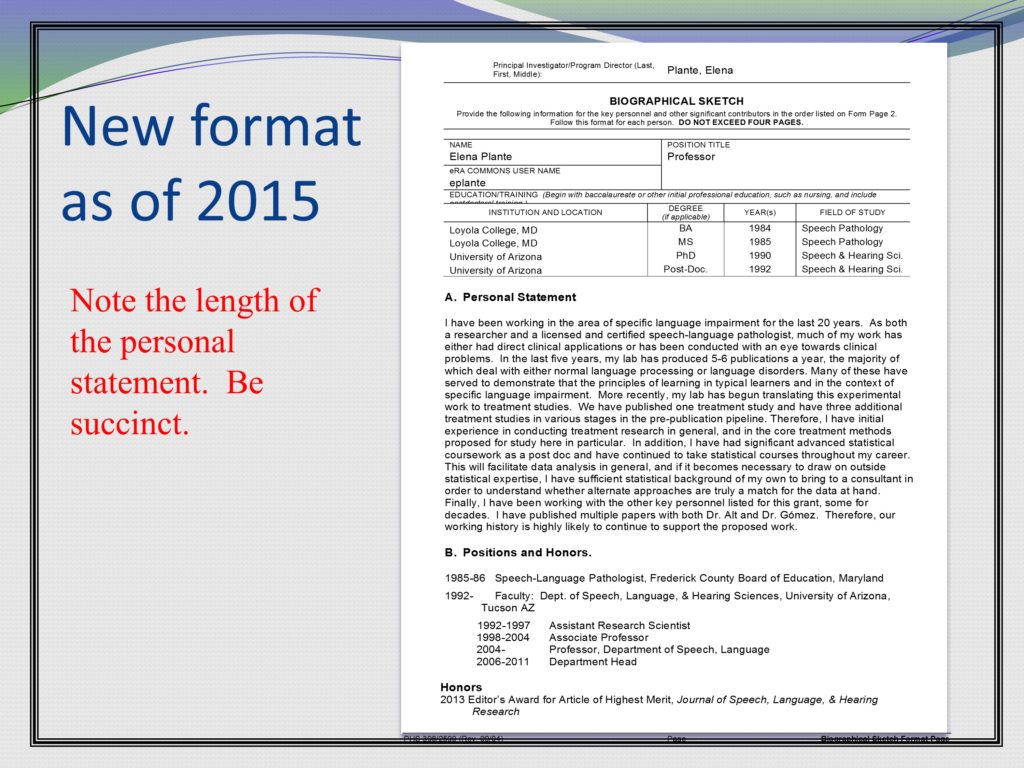 Here’s my biosketch that I’ve used for grants that get funded. You see how long it is? That’s it. I say, “Here’s what I know how to do. I’ve been working with these people. We’ve done these past things together. And that’s why I can do the work I’m proposing to do.”
Here’s my biosketch that I’ve used for grants that get funded. You see how long it is? That’s it. I say, “Here’s what I know how to do. I’ve been working with these people. We’ve done these past things together. And that’s why I can do the work I’m proposing to do.”
Then there’s a section on positions and honors. That’s in the instructions. It’s very clear.
New in 2015: Contributions to Science
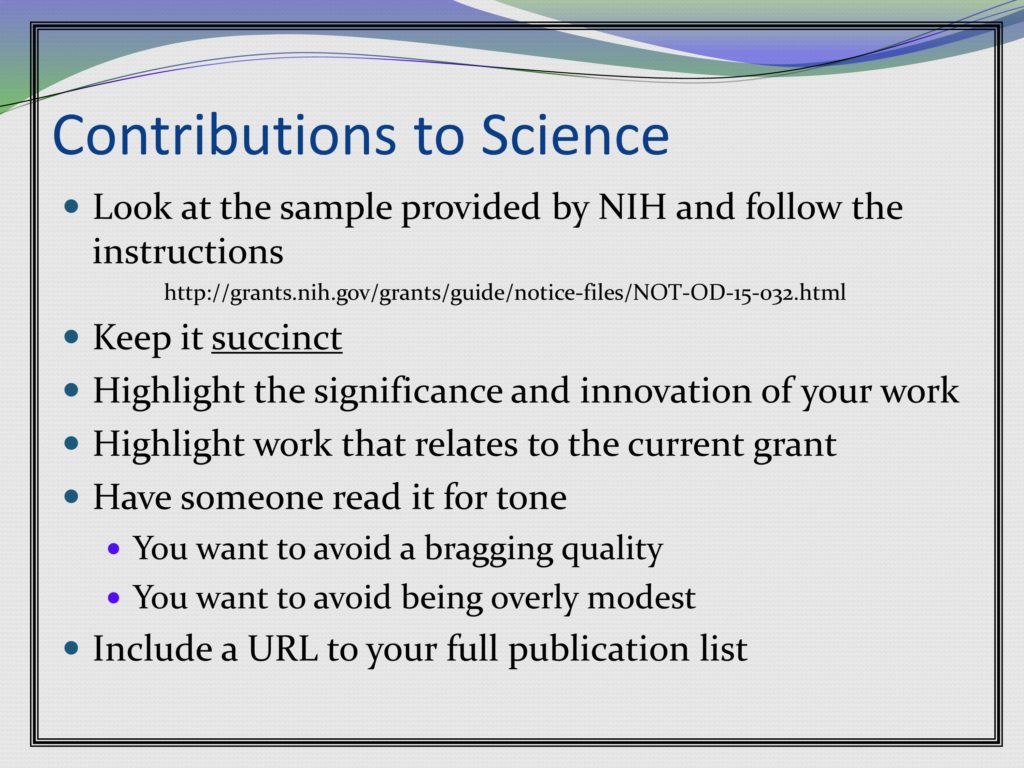 New this year are sections on contributions to science. I can’t tell you concrete tips about this because, frankly, the review committees haven’t seen them yet. But I can anticipate what people are going to think.
New this year are sections on contributions to science. I can’t tell you concrete tips about this because, frankly, the review committees haven’t seen them yet. But I can anticipate what people are going to think.
There is an example on the NIH website about what kind of information they’re looking for in this section. And I’ve given you a mockup of what mine will look like.
Follow the instructions.
Keep it succinct. Again, we’re talking probably about a paragraph per section. Dollar a word.
Highlight the significance and innovation of your work. This is a nice opportunity to do that.
Highlight the work that relates to the grant you’re proposing. So make it really clear that you have expertise in the area that you’re proposing to work in.
Have someone else read it for tone. Two problems I’m anticipating are ones that have an overly bragging quality to them, or ones that are overly modest — where there impact doesn’t come through. There might be impact there, but you’re not selling it. But you don’t want to sell it too much. So have somebody else read this.
You also now need to include a URL to a full list of your publications. That could be your website, if you have one that you keep up. I sadly don’t — I have one, I just don’t keep it up. But the NIH also offers a format that’s linked to PubMed that will automatically populate your new pubs. I did go to that site, and it is relatively easy to populate.
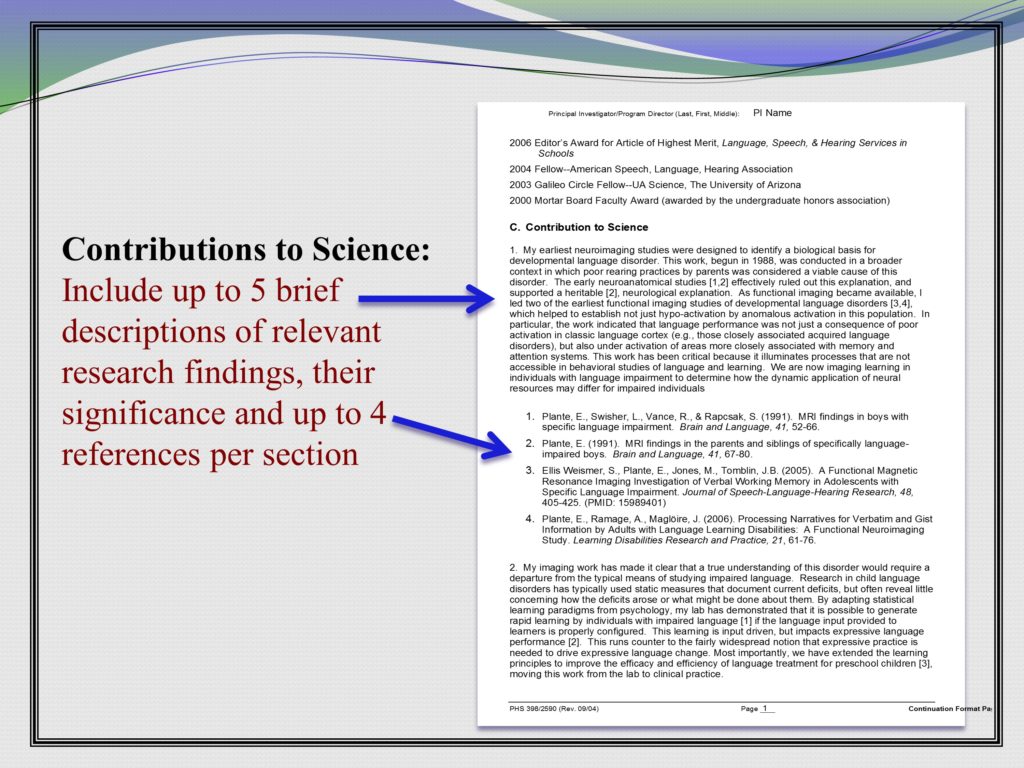 Here’s a mockup of what it’s supposed to look like. You can see a paragraph, then you give up to four relevant publications. There’s another paragraph on another area of science I may have contributed to. Up to four publications. Up to three more of these.
Here’s a mockup of what it’s supposed to look like. You can see a paragraph, then you give up to four relevant publications. There’s another paragraph on another area of science I may have contributed to. Up to four publications. Up to three more of these.
Audience Question: Can you list software or other products that aren’t articles?
If you have developed software, you could provide a link to the software. If you have a patent in the area, you can provide that information. What I would be careful about is providing things like talks. ASHA Leader publications. I would avoid things that are not peer reviewed in some way. You absolutely don’t want to look like you’re trying to pad things out by including things that wouldn’t stand up to scientific muster.
Audience Question: Does this disproportionately place junior scientists at a disadvantage?
That occurred to me as soon as I saw this. That it’s much easier for me to come up with three areas of major contributions to science and four publications that relate to each than it is for somebody coming out of the gate.
But on the other hand, bear in mind that NIH has a number of grant mechanisms designed for junior-level people. I don’t think I would expect to see three for a junior-level person, because I would think, “Well, why do they need a K award, if they’ve already made three major contributions to science?” I wouldn’t worry about that so much.
What you do want to spend some time thinking about is that your research must be programmatic in order to pull this off. You need to think about that up front.
Also, many experienced investigators won’t be including all five different areas of contribution that are allowed in the new format. I don’t think I could come up with five. I have a hundred publications plus, and I don’t think I could come up with five.
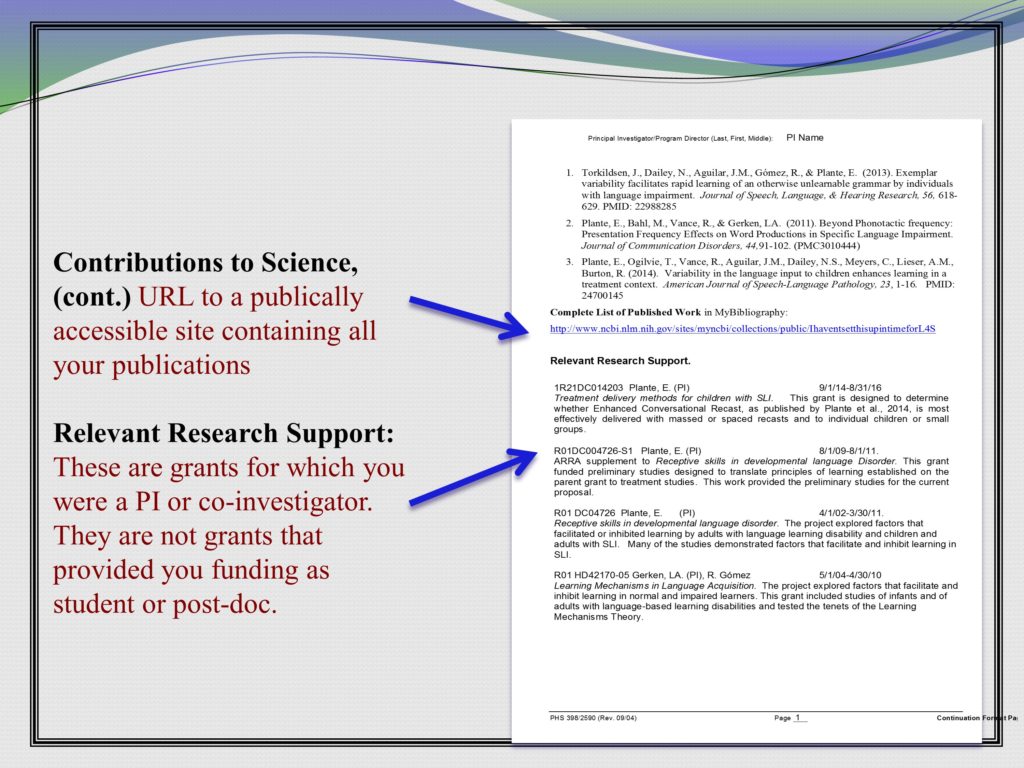 Here’s the rest of it. You can see, there’s the URL to your full list of publications. Here’s your relevant support. The major mistake I see from junior people here is they put grants here that funded them as a research assistant. If the grant was not in your name, or you were not a co-investigator on the grant, it’s not your grant.
Here’s the rest of it. You can see, there’s the URL to your full list of publications. Here’s your relevant support. The major mistake I see from junior people here is they put grants here that funded them as a research assistant. If the grant was not in your name, or you were not a co-investigator on the grant, it’s not your grant.
I see junior people putting down under their relevant support T32 grants. I’m like, “I sorry, nobody awarded you a T32 grant. Nobody did that.” It’s grants that were awarded to you as a PI or co-investigator.
But it does include F awards, because that was awarded to you.
Adding Consultants
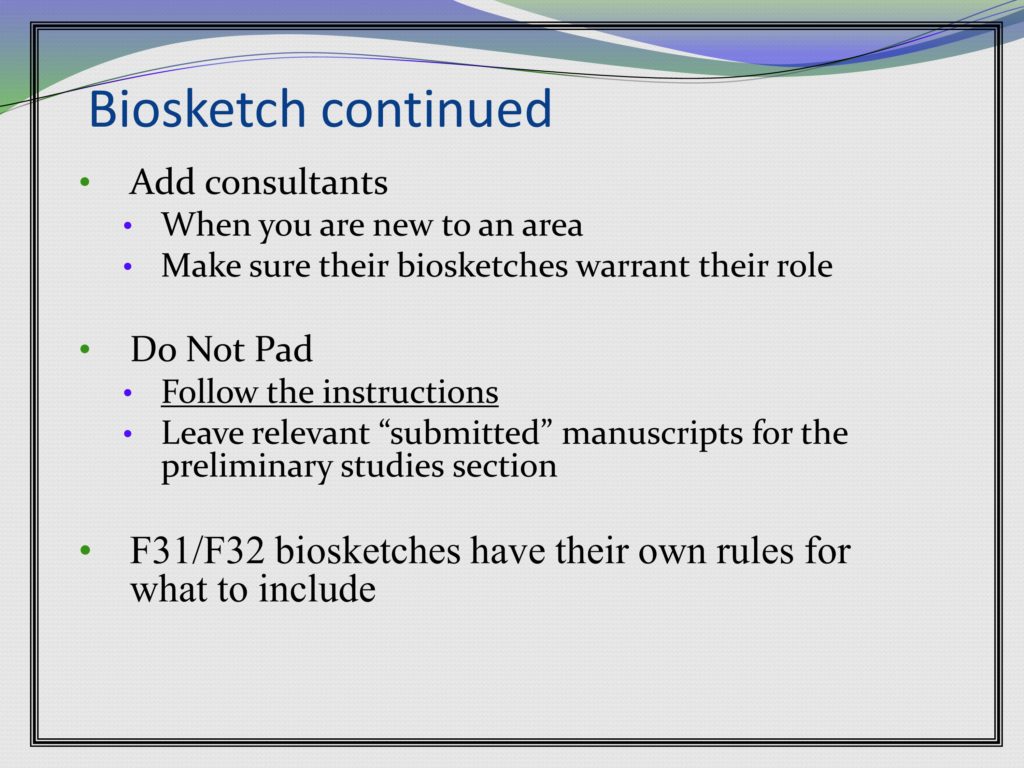 Add consultants when you’re new to an area, or to fill out an area of expertise. Make sure their biosketch actually warrants their role. Over my career, I have met quite a few people who talk a good game, and then when I got their biosketch I was like, “Oh, no. This is not going to work. They haven’t published anything in ten years. That’s not going to fly.” Make sure that the biosketch — we don’t know these people personally, so make sure their biosketch represents the level of expertise you need them to do.
Add consultants when you’re new to an area, or to fill out an area of expertise. Make sure their biosketch actually warrants their role. Over my career, I have met quite a few people who talk a good game, and then when I got their biosketch I was like, “Oh, no. This is not going to work. They haven’t published anything in ten years. That’s not going to fly.” Make sure that the biosketch — we don’t know these people personally, so make sure their biosketch represents the level of expertise you need them to do.
Questions and Discussion
How many publications should you have?
It really depends on the nature of the work you’re proposing. Also, one Science article kind of trumps three other articles. So, there’s no good answer to that. But I would say that if I don’t see minimally one article per year of funding, I’m going to be a little bit suspicious.
I can envision a situation where that would not necessarily happen, particularly with a longitudinal study, but that would be as a reviewer my bare minimum of what I would expect.
Audience Comments:
- This is an interesting point, because different people have different opinions. I can’t tell you how many times I’ve been in a study section and someone said, “Well, there are 13 publications, but only three of them where he is or she is first author.”
I say, “I don’t care. There are 13 publications. That’s a lot.” But I don’t always win that argument. Or, “There are a lot of students on these papers.” — Well good! It is tough. I don’t have a magic number except to say zero is not good.
And if your research is of the type that it’s not going to produce — like I can only run one subject at a time for a short period of time because I spin them — then put that some place.
- Help the reviewer understand the context. But also, this is a really good area to get some mentoring from somebody else who submits to the panel your grant is likely to go to. Because over time, those panels develop a culture that if very much influenced by the fields that the panel is composed of. So having some mentoring about what the expectations are for that panel might be very helpful.
- What I’ve noticed, and this might be strictly anecdotal, is that if the reviewers are excited about the proposal, then just give them enough ammunition so they can defend that you’re the right person to do it. If they don’t like it, then I get comments like what was just said. It doesn’t really seem to be dependent on the number of publications directly. It really seems to be on the general enthusiasm for the proposal.
- I think the number of publications is most important when you’re doing a continuation. If you get an R01, and then you go in for a second round for your R01, you really, really need to have publications that reflect productivity during that period. Again, there’s no magic number, but the reviewers are looking for things that reflect the actual work that they supported.
How does it appear to the review panel when somebody doesn’t have publications in the area, but has a lot of pilot data demonstrating they can do the work?
I would strongly encourage you to get the stuff in the pipeline, in press, before the grant goes in. Lots of people can play around. But if you can publish it, that’s a different level. That goes back to the very first slides: before you even start putting your fingers to the keyboard, think about what has to get out of your pipeline to position the grant optimally.
Audience Comments:
- This is a perfect place, I think, for a new or more seasoned investigator to find a collaborator. If you don’t have the published work, and this is what you really envision as the gap that needs to be filled, that’s a really great strategy for handling that problem.
- Bringing this back to the biosketch, if you have collaborators or someone you’re working with, and they have to submit their biosketch, it’s really important for them to say in that first paragraph what they’re going to contribute to your project. I read proposals all the time where the person is talking about their own work, but I don’t know how it’s going to relate to what you in particular are doing.
- As a new investigator, you can’t be afraid to go back to these people and say, “Can I alter this for you?” Or, “Will you be willing to put in something about what your specific contribution to my project is?”
- As the PI, I write them for collaborators. I just write them for my colleagues, and that way I know what the gist of the whole looks like.
Further Reading: Online Resources of Interest
National Institutes of Health. (2014). Grant Writing Tips Sheets. Notice Number: NOT-OD-15-032 (Available from the NIH Website at http://grants.nih.gov).
National Institutes of Health. (2015). Frequently Asked Questions: Biosketches. Grants & Funding: Frequently Asked Questions (FAQs): Application/Progress Report Information (Available from the NIH Website at http://grants.nih.gov).





